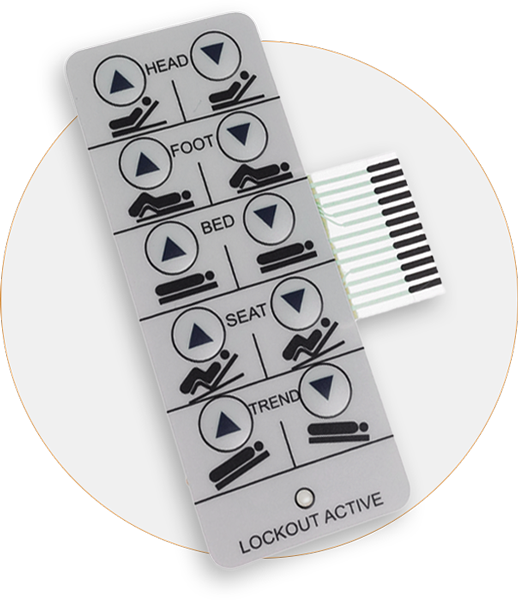Discover Just How a Membrane Switch Enhances Durability and Performance in Instruments
Discover Just How a Membrane Switch Enhances Durability and Performance in Instruments
Blog Article
Exactly How Membrane Switches Contribute to the Sturdiness of Electronic Control Panels
Membrane buttons play a vital function in boosting the durability of digital control panels, largely through their multi-layered construction which provides effective security versus environmental elements such as dampness and dirt. The absence of moving parts significantly lowers the probability of mechanical failures, making membrane layer switches over ideal for requiring applications.
Meaning of Membrane Buttons

Membrane layer switches are designed to be thin and lightweight, making them suitable for applications where space is limited. They can be produced in various shapes, dimensions, and colors, using flexibility in design that satisfies aesthetic and functional needs. Furthermore, membrane layer switches can include various technologies, such as responsive feedback and LED indicators, boosting customer experience.
As a result of their construction, membrane layer switches are commonly immune to dirt, moisture, and basic wear, contributing to their longevity sought after environments. Their smooth layout not only facilitates very easy cleaning yet likewise minimizes the threat of mechanical failure, making them a preferred choice for manufacturers seeking trusted individual interfaces in their electronic control panels.
Protection Against Ecological Variables
The style of membrane switches naturally gives a level of protection versus numerous environmental elements, which is important for keeping functionality in tough conditions - Membrane Switch. These switches are typically created with layers of versatile products that secure interior components from dampness, dirt, and pollutants. By encapsulating the wiring, membrane layer switches over lessen the risk of short circuits and rust, which can considerably hinder efficiency
Moreover, the usage of robust adhesives and sealers during manufacturing enhances their resistance to ecological difficulties. Membrane switches can sustain direct exposure to chemicals and solvents, making them suitable for industries such as food processing and healthcare, where hygiene and sanitation are paramount. Their seamless surface layout additionally stops the build-up of dirt and bacteria, facilitating much easier cleansing and maintenance.
Temperature variations are one more ecological issue, and membrane layer buttons are engineered to operate properly across a large range of temperature levels (Membrane Switch). This adaptability ensures that control board continue to be operational in various settings, from commercial environments to customer electronic devices
Influence On User Communication
Customer interaction with electronic control panels is this dramatically influenced by the style and capability of membrane switches. These switches offer a responsive user interface that enhances the total customer experience, enabling intuitive navigation and control. Their receptive nature ensures that customers obtain instant responses upon activation, which is essential for tasks needing precision and efficiency.
Moreover, the smooth surface area of membrane layer switches helps with very easy cleansing and maintenance, promoting user self-confidence in the integrity of the user interface. This cleanliness is especially essential in atmospheres where hygiene is paramount, such as clinical or food handling settings. Additionally, the portable and lightweight style of membrane switches adds to the visual allure of control panels, urging user engagement with a modern and smooth look.
In addition, the combination of visual aspects, such as printed symbols and backlighting, aids users rapidly determine functions, minimizing the learning curve connected with new devices. As an outcome, users can run tools better, causing increased performance and contentment. In summary, membrane switches play an essential duty in improving user communication by combining performance, aesthetics, and simplicity of use, ultimately causing improved operational effectiveness.
Style Adaptability and Personalization
Design flexibility and modification are necessary facets of membrane buttons, allowing manufacturers to tailor digital control panels to details applications and user needs. This versatility permits the combination of various style elements, such as shades, graphics, and textures, which can boost the visual appeal and user interaction of the control panel.
Membrane layer buttons can be tailored in size and shape, suiting a wide variety of gadgets and applications, from industrial equipment to consumer electronic devices. This adaptability makes sure that producers can develop intuitive interfaces that straighten with customer expectations and operational requirements. In addition, go the ability to include one-of-a-kind features such as backlighting or responsive responses additionally enhances usability, permitting an extra interactive experience.
Additionally, the production procedure for membrane changes sustains the rapid prototyping of styles, allowing makers to iterate and refine their principles rapidly. This capacity go to website not only speeds up the growth timeline yet additionally makes sure that the last product satisfies certain functional and aesthetic requirements.

Cost-Effectiveness and Durability
Cost-effectiveness and long life are considerable benefits of membrane switches, making them an appealing option for suppliers and end-users alike. These buttons are generally more economical to generate than traditional mechanical buttons, mostly as a result of their simplified manufacturing processes and the decreased variety of components called for. This cost advantage prolongs not only to preliminary manufacturing but likewise to long-term operational expenses, as membrane layer buttons typically require less upkeep and have a lower failure rate.
Additionally, the longevity of membrane layer switches adds to their total worth. Created from resilient materials, they are immune to environmental elements such as dampness, dirt, and chemicals, which can cause early wear in various other switch kinds. The absence of relocating components reduces mechanical failing, allowing membrane layer changes to maintain functionality over expanded durations.
This toughness is particularly valuable in applications requiring consistent efficiency under demanding conditions, such as clinical gadgets and commercial equipment. Ultimately, the combination of cost-effectiveness and long life makes membrane layer switches over an economically practical selection for producers, offering reliable options that endure the test of time while maximizing financial considerations.
Verdict
In final thought, membrane layer switches substantially boost the resilience of electronic control panels through their durable construction and safety features - Membrane Switch. Overall, membrane layer changes stand for a reliable and cost-efficient selection for improving the durability and performance of electronic control systems.
Report this page